Explore our expert-made templates & start with the right one for you.
6 Popular CDC Tools, Compared (July 2023 Edition)
Before diving into the comparison of popular CDC tools, it’s crucial to understand the intricacies of CDC techniques themselves. Our technical paper, “5 CDC Techniques for Real-Time Data Warehousing in Cloud Environment,” is an invaluable resource, offering insights into essential CDC methods for cloud-based data warehousing and successful implementation practices. This comprehensive guide will equip you with the knowledge necessary to select a CDC tool tailored to your specific needs [Download Paper].
In the realm of modern data-centric businesses, Change Data Capture (CDC) has risen to prominence as an indispensable component. At its core, CDC is a method of database replication that pinpoints, monitors, and records data alterations, which are then relayed to different systems for additional processing or storage. Organizations frequently utilize CDC for various applications including analytics, business intelligence, and generating reports.
CDC’s significance lies in its ability to offload change events to an external system, where they are then processed or stored for future use. Historically, CDC has been leveraged to draw data from operational databases, and channel it into data warehouses and data lakes.
>> Related: Fivetran vs Airbyte vs Upsolver
Given that CDC tools vary in their implementations, unique challenges and limitations can arise, especially when dealing with diverse databases such as MySQL, PostgreSQL, Microsoft SQLServer, and Oracle Database. Additionally, CDC wasn’t originally designed for analytics; its primary function was to replicate changes between primary and secondary databases or read-only replicas. This often leads to database crashes due to storage overflows, especially when periodic collection of change events is involved.
Overcoming these challenges and harnessing the potential of CDC tools can significantly benefit businesses. Change data capture can facilitate access to multiple cloud and on-prem databases, ease the process of managing historical data storage in data lakes, and allow post-replication data transformations. Ultimately, CDC provides flexibility and scalability, which are critical for businesses to thrive in the evolving data landscape.
Selecting the Appropriate CDC Tool
The process of choosing the right CDC tool depends heavily on the specific use case and the size and nature of your business. For instance, businesses with a significant volume of data might prioritize a tool’s scalability and pricing, due to the sheer amount of data they manage. In contrast, companies dealing with smaller data sets might focus more on the ease of use and simplicity of the tool.
Similarly, businesses with large data engineering teams may lean towards developing their own solutions using open-source products. This gives them the flexibility to customize the tool according to their unique requirements. On the other hand, companies with smaller teams might prefer a managed solution that offers a robust support system, enabling them to streamline their CDC pipelines with minimal effort.
In light of these factors, here are some key evaluation criteria to consider:
Supported Data Sources
Not all CDC tools may support your data sources. As such, it’s crucial to confirm their compatibility with your existing systems.
Price
You should consider the overall costs involved, including licensing, setup, training, and maintenance fees. Some tools may offer better value for their price than others. Scale may significantly influence price.
Performance
Assess the tool’s ability to capture and process changes without putting undue strain on your source systems.
Scalability
As your business expands, your data volume will increase. A suitable CDC tool should be capable of scaling accordingly. This may require elastic scalability.
Ease of Implementation and Operation
This refers to the simplicity and user-friendliness of the tool. Some solutions may require considerable technical expertise, while others might be designed with a more user-friendly interface.
Support
A good CDC tool should provide reliable technical support to resolve any issues or answer any inquiries you may have. This is especially important for businesses with smaller teams or limited technical expertise.
Top 6 Change-Data-Capture Tools
Upsolver
TLDR:
Upsolver is a no-code to low-code data ingestion platform for data warehouses and data lakes, providing a reliable and scalable CDC solution at an affordable and transparent price. Upsolver handles high-volume streaming data superbly and seamlessly integrates with popular data warehouses like Snowflake. Its competitive pricing model, especially for organizations replicating more than 10TB per year, makes it a standout choice among competitors.
Pros:
- Very affordable and transparent pricing model, particularly for high-volume data
- Guaranteed data consistency, availability, and ordering
- Automated schema evolution to avoid crashes of pipelines
- Observability and job monitoring features
- Easy to implement and operate
Cons:
- If complex transformations are required in CDC pipelines, basic SQL skills are needed
- Not compliant with Oracle
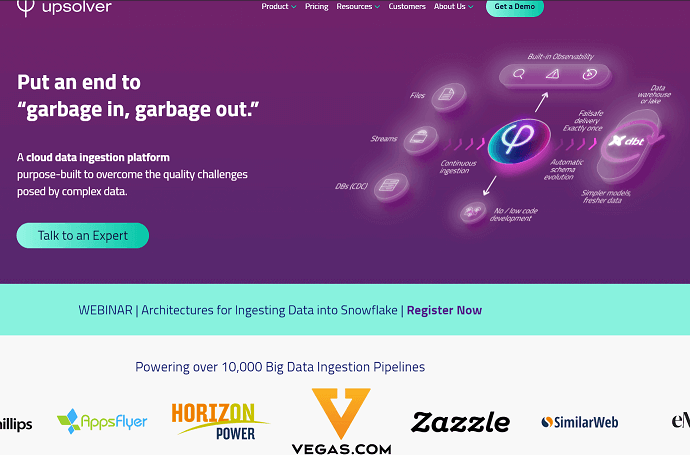
Supported Data Sources: Upsolver currently supports Microsoft SQL Server, plus MySQL and PostgreSQL databases, with MongoDB support expected shortly.
Price: Upsolver’s pricing model is affordable, transparent, and highly competitive, particularly for organizations ingesting more than 10TB of data per year. Unlike other solutions that increase in cost when scaling, Upsolver remains economically viable, ensuring organizations can scale their data ingestion without worry of prohibitive costs.
Performance: Upsolver guarantees reliable performance at scale, offering efficient data ingestion. Its CDC functionality monitors database changes effectively and sends only the changes to the destination, optimizing data transfer and reducing overall load.
Scalability: Upsolver shines in its scalability. With features such as auto-scaling to handle increased data volumes, it ensures consistent performance and avoids transmission errors or pipeline failures due to an increase in scale.
Ease of Implementation and Operation: Upsolver greatly simplifies the process of building CDC ingestion pipelines, saving organizations months of R&D and data engineering. Both technical and non-technical teams will appreciate the intuitive interface that automates much of the pipeline definition process, such as field mapping and table mapping.
Support: Upsolver’s large, knowledgeable, and helpful support team often receives praise from clients, placing Upsolver ahead of many competitors. In addition to product briefs, free trials, and personal demos, Upsolver offers a workshop that equips users with the necessary knowledge and skills to efficiently operate the platform.
Fivetran
TLDR:
Fivetran, a company that specializes in data connectors, has recently broadened its product lineup to incorporate CDC (Change Data Capture) capabilities. While Fivetran’s CDC tool generally demonstrates strong performance, it is important to note that costs can escalate significantly for large volumes of data. Additionally, it is worth mentioning that the tool has limited support for transformations.
Pros:
- Wide array of application connectors, facilitating integration with many SaaS/Web-based applications and databases.
- Excellent technical support, provided you are on the Business Critical support tier.
Cons:
- Fivetran’s pricing can be opaque, with costs potentially increasing unexpectedly due to extensive data syncing.
- Limited transformation options are available.
- Error messages can be non-intuitive, making troubleshooting more challenging.
- High costs for data volumes exceeding 10TB per year, making it less cost-effective for large-scale data operations.
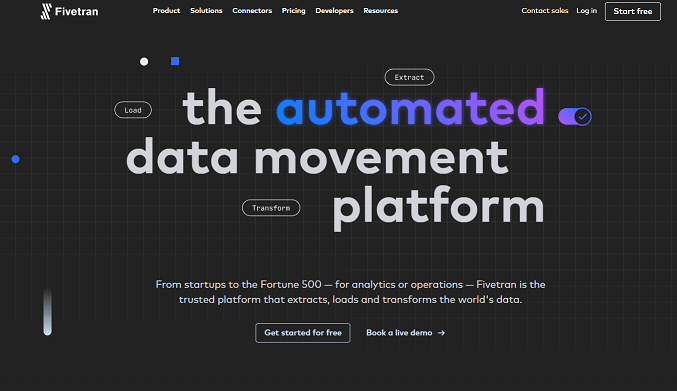
Supported Data Sources: Fivetran earns top marks in this category. Reviewers frequently cite the broad range of connectors as a major advantage. Fivetran supports hundreds of connectors to both SaaS/Web-based applications such as Salesforce, Coupa, and JIRA, as well as database and on-premise connections, with SAP being a highlight for some users.
Price: For low to medium volume of data, the cost of using Fivetran has been deemed satisfactory by many users. However, when data volume exceeds 10TB per year, the service may become expensive. There have been some criticisms about the pricing model, as unexpected cost increases can occur due to extensive data syncing. To control costs, it’s important to carefully select only the necessary data for syncing.
Performance: Fivetran shines in its performance. Reviewers have lauded the efficient and consistent data ingestion Fivetran offers. Its CDC functionality, in particular, has been praised for its ability to seamlessly manage INSERTS, UPDATES, DELETES in your data and track the date/time of those changes.
Scalability: Fivetran can handle data scaling from various sources quite well. However, the cost could become significantly higher than anticipated for larger-scale data needs.
Ease of Implementation and Operation: Fivetran’s ease of configuration and setup is consistently highlighted in the reviews. Users appreciated the simple UI, which allowed them to change basic configurations like frequency of updates, tables/fields to ingest, and monitor usage/billing. Its simplicity also ensures non-engineering teams can handle data pipeline setup, which is seen as a strong advantage.
Support: The support provided by Fivetran is generally viewed as excellent and responsive. Users report that the knowledgeable support team assists them well, although one user mentioned that more detailed logs for data-level object drilling would be beneficial. However, some users expressed frustration with the billing support, mentioning that the team appeared to have a limited understanding of billing and usage issues.
In conclusion, Fivetran offers a comprehensive and easy-to-use solution for businesses in need of efficient data integration, although potential users may wish to scrutinize the pricing model closely to ensure it aligns with their expectations and budget, especially if they plan to operate at scale.
Matillion
TL;DR:
Matillion is an accessible ETL solution renowned for its diverse data source support, performance efficiency, and simplicity in deployment. It operates on a flexible, pay-as-you-go pricing model, offering scalability, but this credit-based system can introduce some uncertainty in predicting overall costs. The tool’s compatibility with legacy systems could use enhancements, providing an area for potential improvement.
Pros:
- Broad Range of Supported Data Sources: Matillion provides a variety of data sources and application connectors, offering effective data integration capabilities.
- Users appreciate the pay-as-you-go pricing model of Matillion for its flexibility, scalability, and perceived good value for money. However, this model can also breed uncertainty as it may be challenging to predict the total cost due to its credit-based nature.
Cons:
- Issues with Legacy System Connectors: Some connectors may not work optimally with legacy systems, creating limitations in data sourcing.
- Clunky User Interface: The user interface can sometimes be challenging, requiring users to learn certain tips and tricks to navigate around quirks.
- Room for Improvement in Scheduling and Upgrading: The software’s scheduling functionality and the process of upgrading versions could be more streamlined.
- Slow Customer Support: While the support team is interactive, users have reported slower responses to their queries.
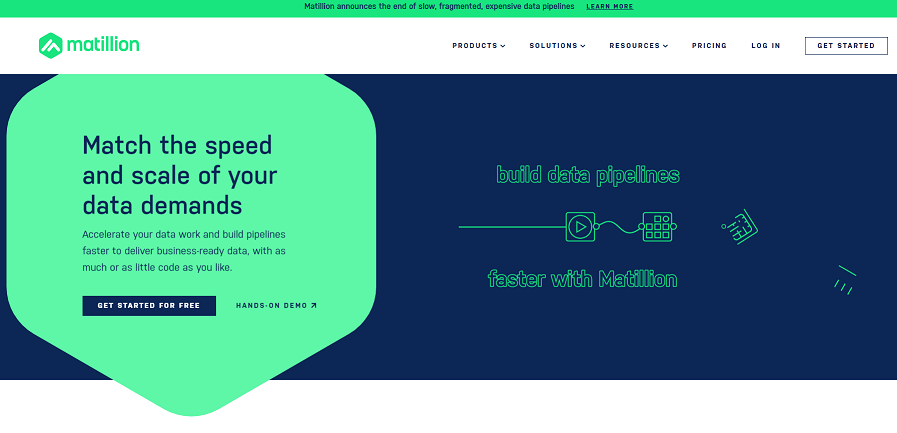
Supported Data Sources: Matillion supports a broad range of data sources and application connectors, although these might require some customization to operate optimally.
Price: The pricing model for Matillion is based on a credit system, where users pay for what they use. While this pay-as-you-go approach offers flexibility and scalability, and is seen to provide good value for money, it also introduces a level of uncertainty as it can be unclear how much users will ultimately have to pay due to the credit-based system.
Performance: Matillion scores high in performance, with users appreciating its no-code, drag-and-drop functionality for orchestration and transformation flows. The software supports fast data transfers when files are available in the cloud and can execute jobs through AWS SQS functionality.
Scalability: Matillion’s cloud-based architecture allows for easy scaling. Advanced features like Python or SQL custom coding, data masking, and data quality checks are praised. On the downside, the scheduling functionality and the process of upgrading Matillion’s version could be improved.
Airbyte
TL;DR:
Airbyte is a free, open-source data integration tool with support for a wide range of data sources, error handling, throttling, and retries. Users value its capability to handle large data transfers and its ease of setup. However, some users encounter issues with scaling, especially with custom connectors, and find the support documentation could be better maintained.
Pros:
- Wide range of supported data sources with customization options.
- It is free and open-source, offering self-hosted or cloud-hosted versions.
Cons:
- Challenges with scaling and intermittent issues with custom connectors.
- Some functionality, like setting up connectors in OSS, can be complicated.
- The self-hosted version lacks a user management feature.
- The help page and support documentation are not always up-to-date.
Supported Data Sources: Airbyte stands out for its wide range of connectors, both source and destination, and allows for customization for specific sources as needed. The tool also supports copying large amounts of data from SQL Server to Snowflake and handling large sources through added checkpointing. It seems to be particularly beneficial for ELT workflows.
Price: Airbyte’s open-source availability is a considerable boon for many users, as its free offering allows access to robust data integration tools. However, it’s noteworthy that the open-source version, despite being free, may present complexities in implementation and debugging. For users grappling with these challenges, particularly when dealing with large data volumes, accessing support can introduce unexpected costs, thereby making the overall expenditure a consideration.
Performance: Airbyte provides effective error handling, throttling, retries, and rate limits. However, some users have mentioned experiencing issues with the scheduler and having to reset Docker & Airbyte for the engine to keep functioning.
Scalability: Although generally praised for its ease of use and the ability to handle large data transfers, some users have experienced challenges when scaling Airbyte. Notably, they reported issues with custom connectors and had to switch from using Kustomise to deploy Airbyte to using Helm Charts.
Ease of Implementation and Operation: Airbyte garners commendations for its relatively direct deployment and operation, be it on cloud platforms or as open-source software. That said, the setup process for open-source software connectors is perceived to be more convoluted compared to their cloud counterparts. Additionally, the self-hosted version currently lacks a user management feature, which can pose a challenge to the streamlined operation of the tool. It’s also important to mention that the open-source version may necessitate a more complex implementation and debugging process.
Support: Airbyte offers various support channels and is reportedly receptive to user feedback. Nonetheless, some users noted that the help page displayed when setting up a new source or destination isn’t always up to date, indicating potential room for improvement in support documentation.
Debezium
TL;DR:
Debezium is an open-source platform for Change Data Capture (CDC) that offers real-time data synchronization across multiple data sources. While it supports numerous popular databases and message processing mechanisms, implementing and managing Debezium requires substantial technical expertise with Apache Kafka and time investment.
Pros:
- Supported Data Sources: Debezium supports a wide range of databases including MySQL, PostgreSQL, MongoDB, SQL Server, Oracle, and DB2, making it versatile.
- Real-Time Performance: Debezium excels in facilitating real-time data synchronization, which is crucial for business insights and decision-making processes.
Cons:
- Scalability Issues: Some connectors have known scalability issues. Large data volumes can quickly overload pipelines.
- Complex Implementation and Operation: Implementation requires expertise in Kafka and DevOps. It also demands custom logic for schema evolution and handling specific data types for certain connectors.
- Hidden Costs: Despite being free to use, Debezium comes with substantial engineering costs in terms of effort and time.
- Support Challenges: As an open-source platform, professional support and up-to-date documentation might not be as robust as with commercial solutions. Responsibility for data integrity and managing data loss lies with the user’s development team.
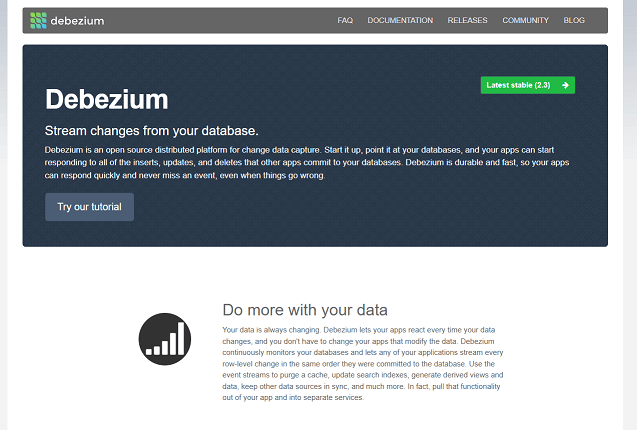
Supported Data Sources: Debezium provides connectors for several popular databases, including MySQL, PostgreSQL, MongoDB, SQL Server, Oracle, and DB2. The architecture also supports other message processing mechanisms such as Google Pub/Sub, Amazon Kinesis, and more.
Price: Debezium is an open-source platform and is therefore free to use. However, it comes with hidden costs as it requires significant engineering effort and time to establish production CDC pipelines. Availability of trained engineers is another factor to consider.
Performance: Debezium excels in facilitating real-time data synchronization, reacting to data changes in a data source, transforming them, and loading them to another database or storage system instantly. This is crucial for business insights and decision-making processes.
Scalability: Debezium’s scalability is problematic in some cases. Even though it provides numerous connectors, some of them are known to have scalability issues. In some instances, users have experienced out-of-memory exceptions, and there are complications while snapshotting large tables. Also, as the volume of data increases with business growth, pipelines can quickly become overloaded.
Ease of Implementation and Operation: Implementing Change Data Capture using Debezium is a complex process. It requires technical expertise in Kafka and DevOps to ensure scalability and reliability. Handling schema evolution requires custom logic in Kafka processing, and different procedures must be followed for different databases. There are also limitations with handling specific data types for certain connectors.
Support: While Debezium is an open-source platform with a user community, maintaining the integrity of data and ensuring zero data loss in case of any component failure is the sole responsibility of the development team. Additionally, up-to-date documentation and professional support might not be as robust as in a commercial solution.
Attunity (now Qlik Replicate)
TLDR:
Qlik Replicate is a robust data replication tool with broad support for various data sources and destinations. It is praised for its speed and minimal operational impact, making it valuable for businesses despite its potentially high entry cost. The tool is known for its performance and scalability, even when handling large data volumes.
Pros:
- Supports a wide array of data sources and destinations.
- Real-time data replication feature.
- Fast and has minimal impact on databases.
Cons:
- High entry cost, although it is perceived as offering significant value.
- Does not fully utilize server capacity for parallel loads.
- Lacks a well-defined alerting system for disruptions or stoppages in replication.
- Improvement needed in error handling and documentation.
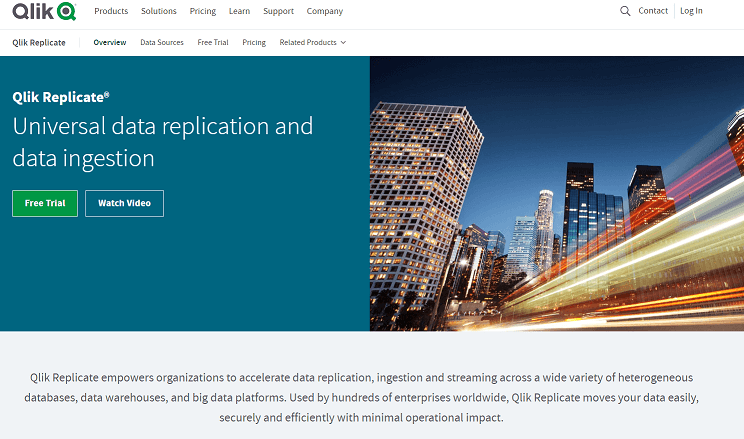
Supported Data Sources
Qlik Replicate (formerly Attunity) supports a vast array of data sources and destinations, providing real-time replication capability, which is a highly appreciated feature among its users. It also features CDC (Change Data Capture), making it a highly suitable tool for data replication from various data platforms to a common data hub.
Price
While the cost of Qlik Replicate is mentioned as a potential drawback, some reviewers also recognize the significant value it brings to their business operations. It’s appreciated for its speed, particularly when replicating SAP databases, and its minimal operational impact on databases. These are important aspects to consider when weighing the cost of the software.
Performance
Qlik Replicate is noted for its performance, with a user mentioning it had not caused any performance issues while loading 50 GB data as part of a POC. Its real-time data replication feature is praised for helping build robust ETL jobs. The tool seems light on system resources, which is considered a significant advantage.
Scalability
The tool has been used for handling large volumes of data, with customers utilizing it for real-time data extraction and loading, reducing development time and cost. However, some users indicated the tool doesn’t use server capacity to its full potential for parallel loads.
Ease of Implementation and Operation
Qlik Replicate is described as user-friendly and easy to install. Its user interface is straightforward and understandable, even for platforms such as Oracle or SQL Server.
The tool lacks a well-defined alerting system for when something breaks or replication stops working. Users had to create such a system themselves, taking effort and time to implement. There’s also room for improvement in error handling according to some users.

